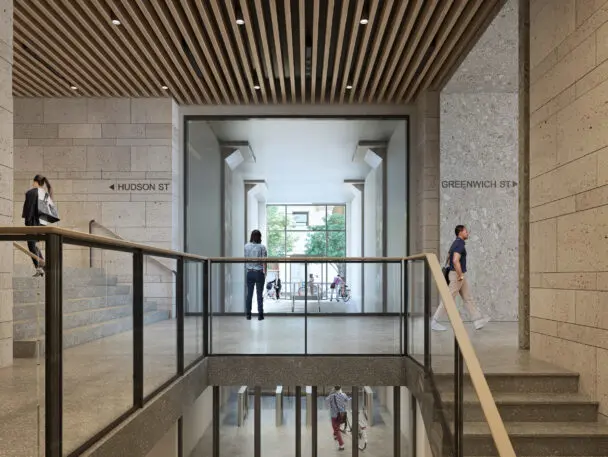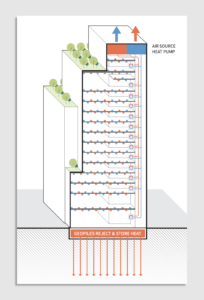A typical office building in New York City uses huge amounts of energy for heating and cooling. A new 16-story office tower in Manhattan takes a Nordic-inspired approach that’s fundamentally more efficient: One system, based on heat pumps and water-filled pipes, is designed to move heat where it’s needed on each floor, between floors, and even to and from the building next door.

The building, at 555 Greenwich, is expected to use 80% less energy than an average large office building in the city. That goes well beyond a city law that requires requirements large buildings to slash emissions 40% over roughly the next decade, with the first cuts beginning in 2024.

High-level design work began in 2018, and New York City passed the energy law for buildings the following year. “We really asked ourselves, do we want to be a bit more aggressive?” says Mike Izzo, the senior vice president of carbon strategies for Hines, one of the partners in the development company behind the project. “Do we want to build the last old building in New York?”

They took inspiration from architecture in Norway and Sweden that rethinks how to use heat efficiently. When the team built the foundation, with posts that go around 120 feet underground, they incorporated a geothermal heating system, which uses the steady temperature below ground to move heat to and from the building. “We’re using the pilings as basically fingers into the Earth to store and extract energy,” Izzo says. Architecture firm CookFox worked on the design with engineers from JB&B.

Heat from underground travels through water in pipes to the roof, where additional “air source” heat pumps extract heat from the air. The system can also run the opposite direction to provide cooling. “We’re integrating all the systems and are able to choose the most efficient energy source at any given time,” he says. Then the heat is sent into the building’s hot water system, and into a system of tubes for radiant heating built into each floor. As hot or chilled water travels through the concrete floor, each office can stay at a comfortable temperature with little energy use. A sensor system tracks occupancy to know where people are working. A separate system pulls in fresh air for ventilation, bringing 70% more outside air to occupants than a typical system.

Next door, in an office tower built in 1931 that’s owned by the same property company, the team is slowly retrofitting each floor to remove old steam heating that runs on fossil fuels, and adding more heat pumps. The two buildings also connect. On a cold day, when one building might be warmer because it has a wall facing west, it can send excess heat to the other building. (In Sweden and a few other locations, utilities use a similar principle to move extra heat from data centers to homes that need heat.) Artificial intelligence will help the system move heat to the right places at the right times, and will also use weather forecasts and occupancy data to help predict demand.

When New York State eventually moves to 100% renewable electricity, by 2040, the heating and cooling system will have no carbon footprint. (Right now, because the building runs on electricity, it has a lower carbon footprint than fossil-based heating, but the electric grid still has emissions.) It could be a model for other office buildings in the city and other cold-weather climates. Already, nudged in part by NYC’s new building energy law, other developers are beginning to unveil new buildings that use geothermal power. An apartment building being developed in Brooklyn, for example, is planning to use geothermal heat for its more than 800 apartments in five buildings.
Recognize your brand’s excellence by applying to this year’s Brands That Matter Awards before the early-rate deadline, May 3.
